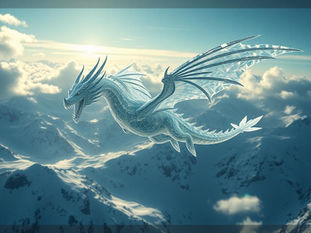
Direct AI Video: Create Pro Camera Shots with AI Tools
Apr 30
6 min read
0
0
0

Imagine making AI video where the camera tells the story, not just follows action. This guide shows you how to control your virtual camera in tools like Runway. You can make cinematic shots that go beyond what the AI does by itself.
Making films for many years taught me how camera movement makes viewers feel things. Excitement, fear, sadness – the camera helps create these feelings. Now, AI video is another way to tell stories. The AI is a partner, but you are the director.
Here's a tip: Don't just use the default camera controls in AI video tools. They often use simple arrows for direction. A real director thinks about mood, rhythm, and how the scene feels. You aren't just moving a camera; you are painting with visuals.
Important: The video examples shown started with images from Midjourney. Then they were refined in Kaya, and finally made into video in Runway. Editing often happens in programs like Adobe Creative Suite, adding sound and effects. You dont have to use these exact tools, but understand that different steps are often needed to get the final look.
Creating the right starting image in Midjourney is a key first step for this process. To make creating these base images easier, consider using the Midjourney Automation Suite from TitanXT. It helps streamline your Midjourney workflow.
Ready to make your AI videos look more like professional films? Let's get started learning about camera moves.
Start Simple: The Static Shot
The easiest, but strong, camera technique is the static shot. The camera stays in one spot. It does not move at all.
Why use it? It makes things feel stable or calm. It can also make the viewer focus on something specific, like a character or a small detail. If a static shot lasts a long time, it can even build tension. The viewer waits for something to happen.
To try this in AI video, use words like:
stationary
fixed
no camera movement
locked shot (means the camera is truly fixed)
Be aware: Even with these words, AI tools sometimes make the shot slightly shaky instead of perfectly still. This might not be what you want if you need a totally steady shot for visual effects.
Using Handheld Movement
That slight shaky look you sometimes get from AI static prompts? It's like a handheld shot. This style has its own good points. The small shifts in the camera can add energy. They make a scene feel more real, like someone is holding the camera.
Handheld shots work well in scenes with action or strong feelings. A static shot might feel too stiff there. The unsteady camera can also make the audience feel a little uneasy. This is good for thrillers or horror.
To aim for a handheld feel, use words like:
handheld
shaky
dynamic movement
Using handheld style can make your AI animations feel more real and intense.
Giving Your Camera Direction
Let's move to shots where the camera intentionally moves. These add a new layer to your story.
Pan Shots
A pan shot is when the camera turns side to side from a fixed point. Think of turning your head. It's used to follow something or show new things in the scene, which can create suspense.
In AI, you might try words like "pan," "side to side movement," or "horizontal pivot." But AI might not know *where* the movement should start or end. A better way sometimes is to make a wide shot first. Then, use editing software to move the view across the shot like a pan.
For fast pans, called whip pans or swish pans, make two different shots. Then add a fast transition between them in your editor. This boosts energy in the scene.
Tilt Shots
A tilt shot is when the camera moves up or down (its vertical angle changes). This is how you slowly show something tall, like a building, or something big and deep, like a canyon.
Tilting also shows how big or small a character feels in their environment. Use tilt shots to make a character seem tiny and alone or large and powerful.
For these, use words like:
[LI]tilt up[/LI>
[LI]tilt down[/LI]
[LI]vertical movement[/LI]
[/UL]
These words tell the AI you want the camera's view to change up or down.
Dolly Shots
Dolly shots are strong for showing feeling. The camera moves smoothly on a track toward or away from the subject.
A push dolly (camera moves closer) pulls the viewer in. It makes you feel closer to the character or the action. A pullback dolly (camera moves away) makes distance. It can show a character is alone or small.
To get a dolly effect in AI, try words like:
camera push in
smooth pullback
tracking shot (suggests a smooth line)
Remember the section about making things look polished? The dragon fire example showed you might need to add things later. In that case, the fire was added in post-production because the AI struggled with complex effects during the video creation.
Making the base images in Midjourney is key for these more complex shots. Using a tool like the Midjourney Automation Suite by TitanXT can help you create the precise images you need before you even get to the AI video step.
Zoom Shots
Zooming changes the frame size without the camera moving. Zooming in fills the screen with detail. It makes emotions stronger or focuses attention. Zooming out shows more of the setting, giving context or showing a large space.
AI tools can sometimes mix up zooming and dolly shots. To make sure you get a true zoom (camera stays put), start your prompt with "static shot." Then add words like:
zoom in
zoom out
gradual zoom
Also, say *what* you are zooming toward or away from, like "zoom in on the character's face" or "zoom out to show the landscape."
Zooming out can be hard for AI because it has to guess what to show. Often, the best way to control zooms is to make a high-quality base video and add a digital zoom effect in your editing software later. This gives you full control over the speed and when the zoom happens.
Boom, Crane, and Jib Shots
These movements add vertical motion and wide views. They can make a scene feel grand or large.
Boom Shot: Camera moves straight up or down without tilting. Gives a smooth vertical lift or drop.
Crane Shot: A bigger, sweeping vertical move, often starting high and coming down. Adds scale, good for epic scenes.
Jib Shot: Shorter, controlled movements, often in an arc. Adds subtle changes in view or depth between subjects.
For these in AI, try words like "high angle," "crane shot," "sweeping vertical motion," or "jib movement." AI might find these complex. Try to keep your prompts clear and simple. Say how far or fast you want the move.
Using these shots can make your AI videos feel bigger and more dramatic.
Tracking and Leading Shots
These shots pull the viewer right into the action. They make you feel like you are there.
Tracking Shot: Camera moves alongside a subject, following them. Keeps focus on the character or object and shows movement.
Leading Shot: Camera moves in front of the subject. The viewer sees what's coming next, staying connected to the character's journey. Good for tension or discovery.
In AI, you can try words like "camera tracking subject," "leading shot," or "front-facing tracking shot." Be clear about the path the camera should take. Mention "smooth tracking" or "continuous forward movement." These shots are strong ways to make your story more immersive.
Point of View (POV) Shots
A POV shot puts the camera in a character's eyes. The audience sees the world exactly as the character sees it. This is very personal and can create strong feelings like empathy or suspense.
To aim for this in AI, start your prompts with:
point of view shot
first-person view
character's perspective
This tells the AI to make the view look like the character is looking.
You Are the Director
Even with AI tools, you are still the creator. The tools don't make magic by themselves. Your ideas, your vision, and your effort bring the story to life. AI is like a brush; your creativity is the artist.
Step into the role of director. With you guiding the AI, there's no limit to what you can create.
Remember that getting the perfect image to start with is crucial for these video techniques. Let the Midjourney Automation Suite from TitanXT help you create those initial images efficiently, so you can focus on directing your AI camera.
Keep creating and exploring what's possible with AI filmmaking!






